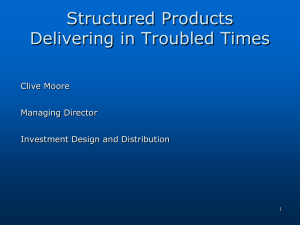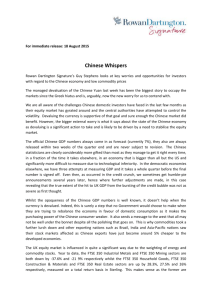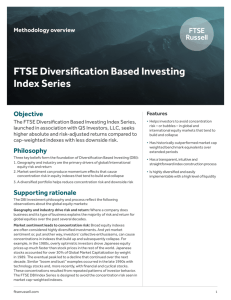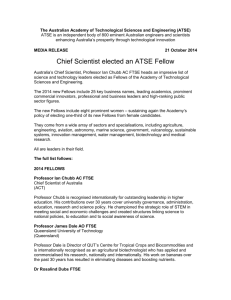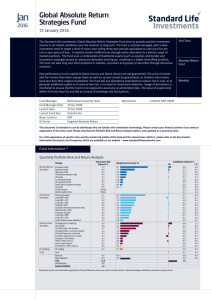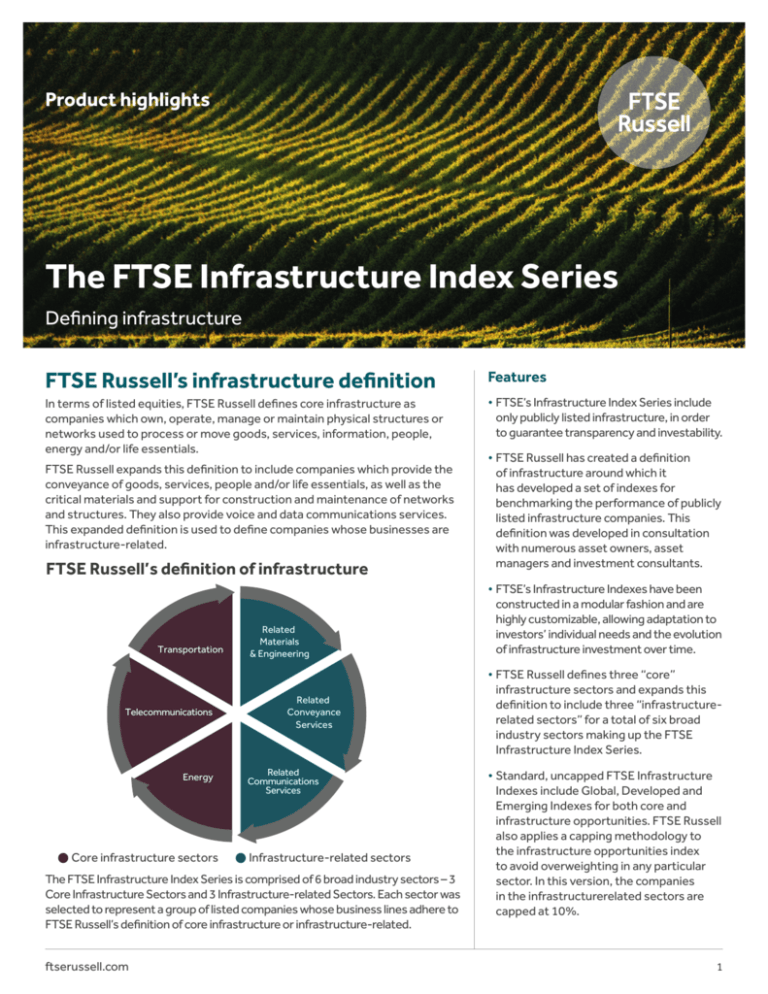
Product highlights
The FTSE Infrastructure Index Series
Defining infrastructure
FTSE Russell’s infrastructure definition
Features
In terms of listed equities, FTSE Russell defines core infrastructure as
companies which own, operate, manage or maintain physical structures or
networks used to process or move goods, services, information, people,
energy and/or life essentials.
•FTSE’s Infrastructure Index Series include
only publicly listed infrastructure, in order
to guarantee transparency and investability.
FTSE Russell expands this definition to include companies which provide the
conveyance of goods, services, people and/or life essentials, as well as the
critical materials and support for construction and maintenance of networks
and structures. They also provide voice and data communications services.
This expanded definition is used to define companies whose businesses are
infrastructure-related.
FTSE Russell’s definition of infrastructure
Transportation
Telecommunications
Energy
Core infrastructure sectors
Related
Materials
& Engineering
Related
Conveyance
Services
Related
Communications
Services
Infrastructure-related sectors
The FTSE Infrastructure Index Series is comprised of 6 broad industry sectors – 3
Core Infrastructure Sectors and 3 Infrastructure-related Sectors. Each sector was
selected to represent a group of listed companies whose business lines adhere to
FTSE Russell’s definition of core infrastructure or infrastructure-related.
ftserussell.com
•FTSE Russell has created a definition
of infrastructure around which it
has developed a set of indexes for
benchmarking the performance of publicly
listed infrastructure companies. This
definition was developed in consultation
with numerous asset owners, asset
managers and investment consultants.
•FTSE’s Infrastructure Indexes have been
constructed in a modular fashion and are
highly customizable, allowing adaptation to
investors’ individual needs and the evolution
of infrastructure investment over time.
•FTSE Russell defines three “core”
infrastructure sectors and expands this
definition to include three “infrastructurerelated sectors” for a total of six broad
industry sectors making up the FTSE
Infrastructure Index Series.
•Standard, uncapped FTSE Infrastructure
Indexes include Global, Developed and
Emerging Indexes for both core and
infrastructure opportunities. FTSE Russell
also applies a capping methodology to
the infrastructure opportunities index
to avoid overweighting in any particular
sector. In this version, the companies
in the infrastructurerelated sectors are
capped at 10%.
1
The FTSE Infrastructure Index Series
Core Infrastructure Sectors
FTSE’s Core Infrastructure Sectors comprise listed
companies that own, operate, manage or maintain a
particular network, structure or facility. These are “nuts and
bolts” constituents whose revenue from operations is similar
to a stable, annuitized cash flow over a relatively long period.
Such companies are typically involved in the construction,
maintenance and/or operation and usage of conduits,
thoroughfares and networks. Revenue from these businesses
often has an element of inflation-linking built in. Long-term
projects may include features to accommodate future price
increases of material and labor. Long-term concessions to
operate or maintain a road, bridge, tunnel or light railway may
accommodate toll and fare increases over time, as necessary.
Port operation and management companies will have some
portion of their revenue linked to usage fees of port facilities.
These companies provide exposure to the infrastructure
asset class, with lower volatility in their returns and
cash flows.
Transportation Core Infrastructure – Companies that
own, operate, manage or maintain roads, bridges, tunnels,
(freight) railway lines, waterways, ports, airports, terminals
and depots. This Sector includes local commuter rail lines
as well as urban mass transit lines, regional light rail and
monorail systems, where the majority of usage is for regular
commutation to and from work.
The FTSE Transportation Core Infrastructure Subsectors
are Railroads; Roads, Bridges & Tunnels; Airports; Other
Ports & Terminals; Commuter Rail & Light Rail; Other
Commuter Transportation.
Freight railway companies which own or manage the
track and/or rightof- way are represented by the
Railroads Subsector.
Companies that are responsible for bridge and tunnel
construction and toll plaza operations, roadway maintenance,
capital infrastructure improvements, toll collection, etc. and
which provide these services via long-term concessions,
are included in the Roads, Bridges & Tunnels Subsector, the
Airports Subsector and the Other Ports & Terminals Subsector.
Within the Commuter Rail & Light Rail Subsector and the
Other Commuter Transportation Subsector are companies
with concessions to operate urban mass transit or local
commuter rail and bus lines, light rail or monorail systems or,
at least part of whose business includes the exclusive right
to collect fares and/or undertake activities and commercial
development of such commuter lines.
Energy Core Infrastructure – Companies that own, operate,
manage or maintain oil, gas or water-supply pipelines or
electricity transmission networks. Companies providing gas
Product highlights
FTSE Russell
and water to regions, cities and neighborhoods via pipelines
and conduits are included. Those with a presence in more than
one energy industry are part of the Multiutilities Subsector.
Core energy companies include utilities and energy
generators as long as they can be shown to operate or own
an economically significant portion of the distribution grid.
Pure electricity generators (e.g. owners or operators of
single, or groups of, power plants) are not included, unless it
can be shown that they also operate or own an economically
significant portion of the local grid to which they contribute
their power.
A key aspect of FTSE’s definition of energy/utilities is the
focus on regulated utilities. Utilities are included if it can be
identified that they are regulated by local, state or regional
governments or agencies. Typically, the regulating body
allows the utility to earn a minimum rate of return. To that
end, the utility is able to pass along some portion of its
conventional fuel costs (i.e. fossil fuels, nuclear or hydro) to
consumers in the form of higher rates, thereby mitigating
the commodity price risk and the volatility of operating
cash flows. This is easier to do with utilities in the U.S.
than it is with utilities in other countries. Outside the U.S.,
regulation may or may not specify a minimum rate of return
and it is more difficult to determine if regulation allows
commodity price risk to be passed along. The result will be
that some large, integrated utilities are not included in the
infrastructure index.
This definition of energy/utilities mitigates the impact from
this sector on the overall index characteristics.
These are the criteria for conventional electricity companies.
For the present, companies generating power via wind, solar,
hydrogen, ethanol or other alternative energy sources, or
which do not have any rights of control over portions of the
transmission grid, are excluded.
The FTSE Energy Core Infrastructure Subsectors
are Gas Distribution; Pipelines; Water; Multiutilities;
Conventional Electricity.
Telecommunications Core Infrastructure – Companies
that own, operate, manage or maintain fixed line telephony
and data networks or, that own, manage, operate or lease
transmission lines or towers to others. Also included
are companies that own, operate, manage or maintain
wireless transmission towers (or, who lease them to others)
and companies that own, operate, manage or maintain
transmission satellites (or, who lease them to others).
Companies providing voice and data communications
are included only if they have control over economically
significant portions of the distribution/transmission network.
The FTSE Telecommunications Core Infrastructure
Subsectors are Fixed Line Networks; Mobile Networks.
2
The FTSE Infrastructure Index Series
Infrastructure-related Sectors
FTSE’s Infrastructure-related Sectors comprise listed
companies that are considered to be part of a country’s
infrastructure because they utilize infrastructure facilities
but do not own, operate, manage or maintain them.
These companies are involved in transportation along the
established infrastructure network, are businesses that
support the construction of infrastructure facilities or are
those that provide voice and data services to end-users.
These companies provide broad, diversified exposure to the
infrastructure asset class, with potentially higher returns,
which are of particular interest to retail investors.
Infrastructure-related Conveyance Services – Companies
that operate passenger rail services, passenger or freight
airlines, bus services, ferries, passenger or bulk container
shipping, trucking or delivery services.
FTSE Russell defines conveyance services as companies that
move goods and people from one place to another. A conduit
or thoroughfare is necessary but not sufficient for a country’s
social and economic development. An unused road generates
no income on its own. Once the conveyance service (trucking,
airlines, container shipping, etc.) is included, commerce
can take place. These businesses represent “everyday
infrastructure” that the average person would equate with
economic development.
It should be noted that the passenger conveyances included in
this sector are not the same as the commuter transportation
included in the Transportation Core Infrastructure Sector. The
difference is subtle, as the same physical rolling stock that
transports working people (i.e. commuters) to and from their
jobs also carry tourists around a city and residents to leisure
activities on weekends. However, a system’s typical pattern
of usage will be considered when making the determination
between commuter and general passenger activity.
The FTSE Infrastructure-Related Conveyance Services
Subsectors are Delivery Services; Marine Transportation;
Trucking; Airlines; Passenger Conveyances.
Infrastructure-related Materials & Engineering – Companies
that provide support services and materials to builders of
infrastructure facilities (e.g. ports, roads, bridges, tunnels,
etc.). These services and materials include surveying
and engineering, cement, concrete asphalt, iron, steel
and aluminum.
Product highlights
FTSE Russell
Materials and engineering are necessary inputs into the
construction of infrastructure facilities and those facilities
cannot be created without them. Projects can have a long
construction timeframe and an even longer maintenance
timeframe. Companies providing materials and services
to these projects can reasonably be expected to receive
long‑term revenue.
While it is not always possible to determine that a company
providing the materials listed above is actually providing them
for an infrastructure project, FTSE makes the presumption
that such companies are engaged in these projects unless
evidence is found to the contrary. It is less detrimental to
include all such companies, on the assumption that at least
some of them must be providing materials for infrastructure
projects, than it is to exclude all of them until direct evidence
can be found from the financial statements that the materials
are, in fact, being used on infrastructure projects.
The FTSE Infrastructure-Related Materials & Engineering
Subsectors are Cement, Concrete & Asphalt; Surveying,
Engineering & Logistics; Iron & Steel; Aluminum.
Infrastructure-related Communications Services –
Companies that provide general voice and data services to
consumers. The rationale used for the other infrastructurerelated sectors applies to Telecommunications as well. Some
companies own or operate the physical network. Others lease
capacity on the network to provide services to consumers.
The large national, regional and global telecoms companies,
who may not necessarily control the network but who utilize
it, would be included in this Sector.
Not all information that is transmitted contributes to the
orderly working and advancement of civil society. However,
there is clearly a societal and economic impact from the wide
availability of mobile communication and internet services
to the masses. For an individual company, one cannot
disaggregate the value of casual phone calls from those of
more societal import. The sheer availability of all forms of
electronic communication must be taken as a whole. We
recognize that impact by including this sector and subsector
within the index series.
The FTSE Infrastructure-Related Communications
Services Subsector is FTSE Infrastructure-Related
Communications Services.
3
FTSE Russell
The FTSE Infrastructure Index Series
Index series design
Summary & conclusion
FTSE calculates infrastructure indexes across global, developed and
emerging markets. The FTSE Global Core Infrastructure Index Series is
comprised of companies from the core sectors which generate a minimum
of 65% of their revenue from infrastructure. The FTSE Global Infrastructure
Opportunities Indexes offer a broader exposure to infrastructure
by combining companies from core and 20% of their revenue from
infrastructure. Finally, the FTSE Global Infrastructure Indexes add a 10%
cap to constituents from the infrastructure-related sectors. This helps to
mitigate the risk of being overweight in a particular sector.
•Government investment in infrastructure
likely to continue to support growing
populations and remain globally
competitive.
Any of FTSE’s Infrastructure Indexes can be customized in terms of region,
revenue threshold or capping factor to meet specific requirements.
FTSE Global Infrastructure Index
•Listed infrastructure provides a
reasonable proxy exposure for unlisted
infrastructure and benefits from
transparent, market-based pricing.
•Definitions of infrastructure vary widely.
FTSE offers a modular, customizable
approach to accommodate broad and
narrow definitions.
10% adjustment
factor to
infrastructurerelated
sectors
FTSE Developed Infrastructure Index
FTSE Emerging Infrastructure Index
FTSE Global Infrastructure Opportunities Index
FTSE Developed Infrastructure Opportunities Index
FTSE Emerging Infrastructure Opportunities Index
FTSE Global Core
Infrastructure Index
FTSE Developed Core
Infrastructure Index
FTSE Emerging Core
Infrastructure Index
Infrastructure-related
Conveyance Services
Infrastructure-related
Communications Services
Infrastructure-related
Materials & Engineering
Telecommunications Core Infrastructure
Energy Core
Infrastructure
Transportation Core
Infrastructure
i Source: The Wall Street Journal Digital Network, Market Watch, September 26th, 2011 (http://
www.marketwatch.com/story/infrastructure-spending-will-create-jobs-geithner-2011-09-26)
ii Source: Morgan Stanley – “Brazil Infrastructure, Paving the Way”, May 5th, 2010 and APE/
BNDES (http://www.morganstanley.com/views/perspectives/pavingtheway.pdf)
Product highlights
4
The FTSE Infrastructure Index Series
FTSE Russell
For more information about our indexes, please visit ftserussell.com.
© 2015 London Stock Exchange Group companies.
London Stock Exchange Group companies includes FTSE International Limited (“FTSE”), Frank Russell Company (“Russell”),
MTS Next Limited (“MTS”), and FTSE TMX Global Debt Capital Markets Inc (“FTSE TMX”). All rights reserved.
“FTSE®”, “Russell®”, “MTS®”, “FTSE TMX®” and “FTSE Russell” and other service marks and trademarks related to the FTSE or
Russell indexes are trademarks of the London Stock Exchange Group companies and are used by FTSE, MTS, FTSE TMX and
Russell under licence.
All information is provided for information purposes only. Every effort is made to ensure that all information given in this
publication is accurate, but no responsibility or liability can be accepted by the London Stock Exchange Group companies nor
its licensors for any errors or for any loss from use of this publication.
Neither the London Stock Exchange Group companies nor any of their licensors make any claim, prediction, warranty or
representation whatsoever, expressly or impliedly, either as to the results to be obtained from the use of the FTSE Russell
Indexes or the fitness or suitability of the Indexes for any particular purpose to which they might be put.
The London Stock Exchange Group companies do not provide investment advice and nothing in this document should be
taken as constituting financial or investment advice. The London Stock Exchange Group companies make no representation
regarding the advisability of investing in any asset. A decision to invest in any such asset should not be made in reliance on any
information herein. Indexes cannot be invested in directly. Inclusion of an asset in an index is not a recommendation to buy, sell
or hold that asset. The general information contained in this publication should not be acted upon without obtaining specific
legal, tax, and investment advice from a licensed professional.
No part of this information may be reproduced, stored in a retrieval system or transmitted in any form or by any means,
electronic, mechanical, photocopying, recording or otherwise, without prior written permission of the London Stock Exchange
Group companies. Distribution of the London Stock Exchange Group companies’ index values and the use of their indexes to
create financial products require a licence with FTSE, FTSE TMX, MTS and/or Russell and/or its licensors.
The Industry Classification Benchmark (“ICB”) is owned by FTSE. FTSE does not accept any liability to any person for any loss
or damage arising out of any error or omission in the ICB.
Past performance is no guarantee of future results. Charts and graphs are provided for illustrative purposes only. Index returns
shown may not represent the results of the actual trading of investable assets. Certain returns shown may reflect backtested performance. All performance presented prior to the index inception date is back-tested performance. Back-tested
performance is not actual performance, but is hypothetical. The back-test calculations are based on the same methodology
that was in effect when the index was officially launched. However, back-tested data may reflect the application of the index
methodology with the benefit of hindsight, and the historic calculations of an index may change from month to month based
on revisions to the underlying economic data used in the calculation of the index.
Product highlights
5
FTSE Russell
The FTSE Infrastructure Index Series
About FTSE Russell
FTSE Russell is a leading global provider of benchmarking, analytics and data
solutions for investors, giving them a precise view of the market relevant to
their investment process. A comprehensive range of reliable and accurate
indexes provides investors worldwide with the tools they require to measure
and benchmark markets across asset classes, styles or strategies.
FTSE Russell index expertise and products are used extensively by
institutional and retail investors globally. For over 30 years, leading asset
owners, asset managers, ETF providers and investment banks have chosen
FTSE Russell indexes to benchmark their investment performance and create
ETFs, structured products and index-based derivatives.
FTSE Russell is focused on applying the highest industry standards in index
design and governance, employing transparent rules-based methodology
informed by independent committees of leading market participants.
FTSE Russell fully embraces the IOSCO Principles and its Statement of
Compliance has received independent assurance. Index innovation is
driven by client needs and customer partnerships, allowing FTSE Russell to
continually enhance the breadth, depth and reach of its offering.
FTSE Russell is wholly owned by London Stock Exchange Group.
For more information, visit www.ftserussell.com.
To learn more, visit www.ftserussell.com; email index@russell.com, info@ftse.com;
or call your regional Client Service Team office:
EMEA
North America
Asia-Pacific
+44 (0) 20 7866 1810
+1 877 503 6437
Hong Kong +852 2164 3333
Tokyo +81 3 3581 2764
Sydney +61 (0) 2 8823 3521
Product highlights
6

